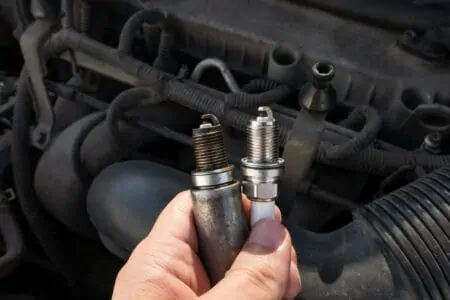If your car is struggling to start or is constantly stalling, you might have an issue with the spark plug. While you should replace the spark plug if you’ve used it for longer than the recommended time, that’s not always the case.
If your spark plug is still in good condition, don’t replace it. Instead, clean it. We’ll walk you through how to clean spark plugs in just a few minutes.
These methods work for vehicles, lawn mowers, motorbikes, and more.
Key Takeaways
- Spark plugs ignite the fuel-air mixture in engines and should be replaced every 50,000 to 100,000 miles, but can be cleaned in between.
- To clean spark plugs, use a brass brush, 220-grit sandpaper, and remove any deposits from the electrode.
- Alternative cleaning methods include using a blow torch, rubbing alcohol, or brake cleaner to remove stubborn debris.
- Factors that cause spark plugs to wear out quickly include leaking oil, carbon buildup, overheating, and poor fuel quality.
What are Spark Plugs?
Spark plugs create a spark of electricity that ignites the vehicle or power tool’s ignition. This electricity spark begins at the ignition coil.
It then travels to the inside of the combustion chamber. The spark will go across a small gap to ignite the fuel-air mixture, firing the pistons into motion and starting the vehicle.
Can You Clean Spark Plugs?
If your spark plug is dirty — typically covered in oil and carbon — it won’t be as effective. While you should replace your spark plug roughly every 50,000 to 100,000 miles, you can clean it in between. You must follow the correct cleaning methods properly so that you don’t cause any damage.
Cleaning Vs. Replacing Spark Plugs
Before replacing a spark plug, we recommend cleaning it. It’s hard to tell if it really needs replacing unless you’ve cleaned it and tried it again within the vehicle or power tool.
However, if you notice any damage, it’s time to buy a new spark plug. Damage includes:
- Heavy carbon deposits that you can’t remove.
- Cracks or breaks.
- The electrode at the top of the plug is burnt, black, green, or damaged.
If the spark plug has been used for longer than the maximum recommended time, we urge you to replace your spark plugs. If it’s going to be a few days or weeks before you can get a new one, clean your existing spark plug. This might help the vehicle run better in the meantime.
For those in the market for new spark plugs, you can buy them at your local motoring retailer or hardware store. For instance, you can buy spark plugs at Home Depot or Amazon. Before buying, always check what spark plug is needed for your power tool or vehicle.
You can expect a spark plug to cost between $5 and $15, so they’re relatively inexpensive. There are various types of spark plugs, such as copper, iridium, platinum, and double platinum.
How to Remove and Check Spark Plugs
To check whether your spark plug needs to be cleaned or replaced, you must remove it first. We’ll walk you through the best way to do this.
- Time: 25 minutes.
- Difficulty: Intermediate.
What You’ll Need
- Spark plug wrench.
- Compressed air.
- Eye protection.
- Reach hose grip pliers.
1. Turn the Engine Off and Let It Cool
It’s essential to work on a cool engine. So turn off your car and let the engine completely cool for a few hours or overnight. If you work on a hot engine, the heat could damage the spark plugs’ threads.
2. Locate the Spark Plug Wires
It’s easiest to locate the spark plugs by checking your user manual. But if you’re familiar with engines, you can find them by following the thick wires that travel from one area of the engine straight to the spark plugs.
3. Blow Compressed Air
Once you’ve found the spark plug wires, you must use compressed air to remove loose dust and dirt around the spark plug wells (or holes). If the debris falls into the spark plugs later, it can cause permanent damage.
Top Tip
Make sure to wear your protective eyewear in case any debris flies up at you.
4. Remove Spark Plug Wires
The spark plugs are located beneath the wires. So first, we need to remove these wires. Pull the wires up by grabbing the top of the housing, not the wire itself.
Gently pull it up, and it should detach. However, some are difficult to remove. In this case, use a pair of reach hose grip pliers to pull the wire out.
5. Blow Compressed Air
Blow compressed air in and around the exposed well. Remove any loosened debris from the area.
6. Remove Spark Plug
Grab your spark plug wrench (sometimes called a socket) and push it onto the plug. Once you’ve located the plug, twist the wrench to loosen it. Then pull it out of the well.
7. Inspect the Spark Plug
First, we look at the end of the spark plug. You will need to clean or replace the spark plug if it’s rusty. You should also look for cracks, breakage, or dents, especially in the ceramic.
Next, inspect the ceramic at the tip, looking for chips and cracks. After this, check the electrode tip for deposits. Thick deposits might not be able to be cleaned, but minor deposits might be easier to remove. However, there is the risk that you will damage the electrode when cleaning.
Next, check the side of the electrode. It might be eroding. The best way to check this is by comparing it to a new spark plug.
You should also check the gap between the top and side electrodes. If it’s wider than a new spark plug would be, then you should replace the spark plug.
Lastly, notice the brown staining around the ceramic. If you see this, don’t worry about it. It won’t affect the spark plug’s ability.
Did You Know
You can adjust the gap of the plug using a gap tool called a spark plug gapper. However, these are roughly the same price as a new spark plug, so it might not be worth it.
How to Clean Spark Plugs
Once you’ve inspected the spark plug and concluded that it doesn’t need to be replaced, it’s time to clean it. Make sure that you don’t use anything too abrasive, as this can damage the spark plug. In this scenario, we will be using 220-grit sandpaper, but you should avoid anything more abrasive than that.
Also, keep in mind that cleaning it might not get a spark plug working again — you might need to replace it anyway.
- Time: 10 minutes.
- Difficulty: Easy.
What You’ll Need
- Brass brush or wire brush.
- Rags.
- 220-grit sandpaper.
- Eye protection.
- Face mask.
- Gloves.
1. Scrub the Plug
Wearing all your protective gear, use the brass or wire brush to scrub the entire tip of the spark plug. Removing all the deposits might take a couple of minutes, so continue until it looks visibly different. Don’t forget to get in and around the tip.
2. Wipe Away Debris
Use your rag to wipe away loosened debris. Shake it out, so you don’t reapply it to the spark plug.
3. Sand the Plug
The small metal electrode sticks out at the end of the spark plug. It can become blackened and harbor deposit buildup.
Slide the 220-grit sandpaper beneath the electrode and move it back and forward to remove the deposits. Continue until you can see the clean metal.
4. Wipe Away Debris
Again, wipe loosened deposits with your rag. You can now return the spark plug to the engine. However, if you’re not satisfied, there are a few more methods you can try. Check these out below.
How to Clean Spark Plugs Without Abrasives
While using a wire brush and some sandpaper is essential to remove deposit buildup, you can clean your spark plug without abrasives. This might not be as effective. However, if you combine the above method with one of these, you will have a spotless spark plug.
With a Blow Torch
Using a blow torch can be super effective if you have a lot of carbon and debris on your spark plug. Remember that this emits seriously high heat, so you must wear protective gloves and use pliers to hold the spark plug.
- Hold the spark plug correctly: Use pliers to grip the bottom of the spark plug (opposite the electrodes). Extra-long pliers are best to keep your hand out of the blow torch’s reach. Alternatively, you can use a bench vice.
- Blow torch the spark plug: Turn on your blow torch and hold the spark plug in the flame until it turns red. This is the heat working off the carbon and debris from the plug. Rotate the plug to heat all sides with the torch, continuing until the electrodes are glowing red.
- Cool down: Once the spark plug is clean, turn the blow torch off and continue holding the spark plug in the pliers until it’s cooled. This can take at least five minutes, but it might take longer, so be extremely careful.
With Rubbing Alcohol
Rubbing alcohol can help to remove deposits, too. If you tried the original method but want something more powerful, add rubbing alcohol into the mix.
- Drench the electrodes: Drench the tip of the spark plug with rubbing alcohol and let it sit on a cloth or rag for one minute, electrode side up.
- Scrub: Use a wire or brass brush to scrub the spark plug clean. Apply more rubbing alcohol as necessary, keeping the electrodes wet at all times.
- Wipe: Wipe the area with a rag to remove residue and loose debris.
- Dry: Leave the spark plug in a well-ventilated spot to air dry. Repeat if necessary.
With Brake Cleaner
One of the best ways to clean spark plugs is by using brake cleaner. In fact, this stuff is great for cleaning many car parts. For spark plugs, it’s super helpful to clean off remaining stubborn filth.
- Spray: Lay the spark plug on a flat surface in your workshop or garage. Spray brake cleaner onto the plug, including the threads.
- Wipe: Use a cloth to wipe the spark plug, and remove loosened grime and deposits.
- Scrub: If necessary, you can scrub the spark plug with a wire brush for a more thorough cleaning.
- Wipe again: Wipe one last time to remove all deposits from the spark plug.
Warning
Make sure you use a non-flammable brake cleaner. Most are but double-check. Spark plugs are subject to a small spark, so a flammable cleaner would be disastrous.
FAQs
Get Your Spark Back
Cleaning spark plugs is a handy skill to know. It takes a bit of a learning curve, but anyone can do it. As long as you follow safety precautions and use the right cleaners, you’re good to go.
Always remember to safely remove your spark plugs and inspect them before cleaning. If there are cracks, damage, or burnt parts, it’s best to replace the spark plug instead of cleaning it.
However, if it just needs a little sprucing, a wire brush, sandpaper and rags are all you need to revive it.
One last thing — don’t go without compressed air. If you skip this step, debris can fall into the spark plug well and damage your engine.










